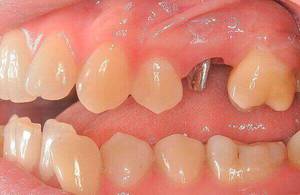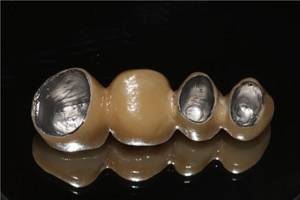A person’s dental tissue is subject to a large amount of stress throughout his life, so it often collapses. Modern dental clinics have a wide range of capabilities and are ready to assist in the restoration of damaged teeth.
The functional and visual properties of the teeth can be restored as soon as possible. For high-quality restoration work, dentists use special inserts under the dental crown. Often caries affects the walls of the teeth, expanding and deepening every day.
Such carious formations create difficulties in the procedure of filling, and there is no guarantee that the tooth will function normally in the future. In such situations, experts practice the use of dental tabs. Stump tabs today are considered the most popular among patients.
Content
Types of dental tabs
Types of tabs under the crown:
- Stump. Made from a wide variety of metal alloys using precision casting. The method of milling is used for the production of tabs under the crown of zirconium oxide and aluminum oxide.
- Ceramic. Required with significant destruction of dental structures. It is important that the destroyed tooth retains two walls.
- Reinforced composite. It has similar parameters of elasticity, as well as ceramic, however, the second is more durable. Composite tab tends to fade under increased load. Unlike the ceramic tab, it is less likely to accumulate scurf. This is because the high temperature and pressure in the dental laboratory create conditions for the full polymerization of the material, which is unrealistic to achieve in the human oral cavity.
- Golden Gradually, this proven method is becoming a thing of the past, but having proven itself, it is sometimes used to repair dental tissue. Despite the aesthetic drawbacks, it has a high service life due to its corrosion resistance. This tab can last more than 20 years.
What is a stump tab?
The stump tab is made on the model of a dental impression. The resulting design is intended for further fixation of the crown on it. With the help of a stump tab, badly damaged teeth are restored.
Whole dental tab design includes two parts. The upper part looks like a stump, which is ground in advance to establish the crown. For this reason, it is called stump. The lower part resembles a rod. The function of the lower or root part is to imitate a pin. Crown part made on individual casts, with the help of their dental technician forms the necessary geometry of the crown. It can be done so that the coronal part will have similarity with the original shape of the tooth. Options are considered when it is used independently, separately from the crown. The lower part is made, starting from the peculiarities of the structure of the tooth, so it is even double or triple. In such a situation, it is advisable to use a collapsible design, rather than an integral one.
Removable elements there are only pinsThis is required to reduce the complexity of the installation, especially if the tooth has a complex multi-channel shape and non-standard channel layout. Mainly stump tabs in the tooth are shown to those who do not have the ability to install a seal or pin due to the lack of dental tissue. When installing the stump tab is achieved uniform load on the tooth, which is impossible to achieve with a pin.
The pin, unlike the stump tab, is installed in one step, but its use does not guarantee that the chewing organ will be intact, and the tooth enamel will not collapse.
Tab mounted on a special cement, which consists of components that ensure a reliable fit of the structure to the tooth. Cement composition provides full tightness and does not allow the formation of cracks. The use of stump inserts is justified when only the root remains or there is no internal filling, and the tooth has thin walls that are prone to destruction. Such constructions not subject to shrinkage over time. This allows you to properly install the crown and prevent its loosening and breakage. Among other things, stump tabs allow you to completely remove the tissue affected by caries, which eliminates its secondary formation and the appearance of pain symptoms under the crown.
Varieties of stump tabs
Stump tabs depending on the type of production are:
- Foldable. It is used in cases when teeth with multiple roots are damaged. This ability is provided by the ability to insert and remove pins. Foldable design is difficult to select and install, however, it is very reliable.
- Cast. Consists of two parts. One is designed for attachment in the dental jaw, and the other is needed to restore the shape of the crown. Make in dental workshops under the condition of high temperatures and pressure.
TO stump tab materials There are many requirements, such as:
- Stability of bioinert. The materials used should not harm the surrounding tissues and the human body as a whole.
- High mechanical strength.
- Minimum shrinkage in the process of obtaining the finished product
- Low thermal conductivity
- Availability and reasonable price
By type of material there are the following products:
- Metallic. The most common alloys based on cobalt and chromium are also found alloys of precious metals. Metal samples are reliable, can withstand multiple loads, therefore, are well suited for the reconstruction of chewing teeth. For aesthetic reasons, they are rarely used in prosthetic front teeth and incisors.
- Metal-ceramic. The combination of metal and ceramic elements. Such a product looks more attractive, but does not have high reliability. Sometimes they fall out due to poor compatibility of components, metal and ceramics can react due to thermal effects, which will lead to a violation of the integrity of the structure.
- Ceramic. Uniform in composition products. With their help, restore the front teeth. Pressed ceramics gives the teeth a sophisticated look, and high-tech manufacturing reduces the risk of developing dental diseases in the area of the installation.
- Zirconium oxide. The heavy-duty design differing in high esthetic parameters. Applied with prosthetic both front and chewing teeth.
Pros and cons of the stub tabs
Stump constructions have many advantages before the previous restoration methods. Their main advantages are:
- Dental crown can be neatly adjusted to the tab
- mechanical and chemical resistance
- dentition undergoes significantly less stress
- possibility of installation on teeth with several roots
- excellent reliability of the product, achieved due to the accuracy of the selection of the form and material
- being a support for dentures, makes it possible to install prosthetic bridges
- most likely to restore even the most damaged teeth
- the specific structure of the structure creates a barrier to the penetration of pathogenic microbes into the cavity of the restored tooth
- if there is damage to the crown, then there is no need to change the tab, as under it creates a new crown
- adjacent teeth are not affected
Cons stub tabsare usually associated with the complexity of the manufacturing mechanism:
- The installation takes a long time, there is no possibility to carry out the restoration of the tooth in one visit. The previous procedures for measuring the cavity of a damaged tooth and the process of material production by a technician take considerable time.
- The cost of materials and work is not available to all
- Correct installation requires high qualifications from the dentist and corresponding experience in prosthetics.
- Before installation, a large amount of tooth enamel is cut
Indications and contraindications to the installation of the stump design
Kultevye tabs are shown in the following cases:
- Coronary tooth structure is destroyed
- There are defects in the shape of the tooth.
- Incorrect tooth placement
- Supragingival defects of the damaged tooth of various etiologies
- The inability to restore the dental crown with the help of filling and other methods
- If support is required to establish a bridge
- As a splinting structure if there are periodontal diseases
Contraindicated:
- There are diseases of the gums in the place of installation tabs
- Damaged tooth root
- Abnormal tooth mobility
- Root canals infected
- Allergic reactions to alloys used for the manufacture of structures
Features of the installation of the stump tab under the dental crown
For all, without exception, patients are selected most suitable types and shapes stump tabs, and then proceed to a phased installation process. The doctor is required to accurately follow the technology to work as efficiently as possible, and the product lasts as long as possible.
- Preparatory stage. Dentist therapist performs manipulations aimed at eliminating foci of caries, treats the formed cavities with antiseptics.
- Impression casting. As soon as the doctor has completed the preparatory work, he is engaged in taking an impression from the tooth being restored, as well as from adjacent teeth. The procedure is necessary for accurate location of the future stump construction.
- Temporary sealing. Such a measure is necessary to protect the cavity formed from negative factors. A temporary filling of simple materials is used while the dental technician makes a tab.
- Computer simulation of dental products. The three-dimensional model acts as an instruction to a specialist who processes the workpiece on a special milling machine.
- Some materials require roasting in a special furnace.
- Installation The finished construction is fixed, and it is necessary to ensure the exact formulation of the molded root product in the prepared cavity. Before the cement mixture hardens, the specialist strongly presses the tab. Then a crown is fitted on the tab, specially made for the stump tab geometry. The result is a dental tab with a metal base and ceramic veneer.
- To eliminate the difference between artificial materials and natural fabrics, sometimes polishing is required.
As soon as the stump tab has been setIt requires thorough oral hygiene. It is necessary to clean the tooth at least twice a day. After eating use antibacterial rinses and anti-inflammatory solutions.It is best to clean the surface of the dental tab with a soft bristled brush. Do not forget about routine inspections and visit the dentist’s office twice a year.
Given the fact that stump tabs are strong enough and surpass in reliability even modern fillings, the term of their services is limited. Made from the simplest materials will serve the patient for at least five years. It is possible to increase the service life if the orthopedic surgeon and the dental technician conscientiously perform their work, then the construction will continue for 7–10 years.







